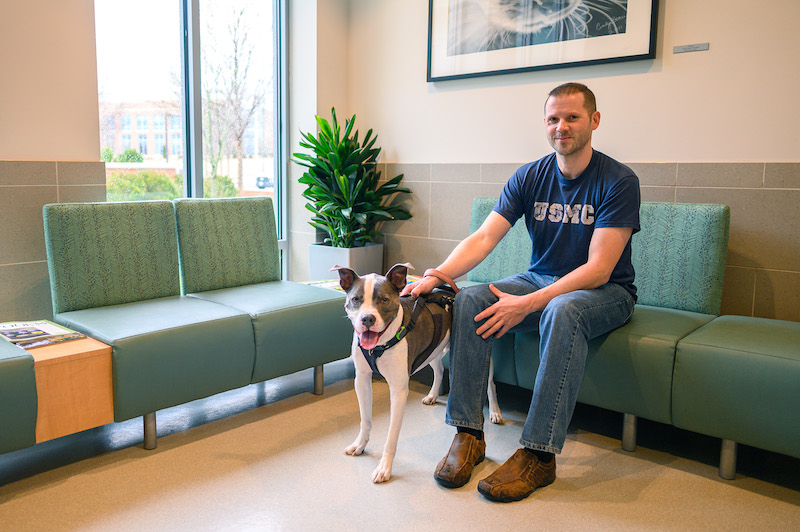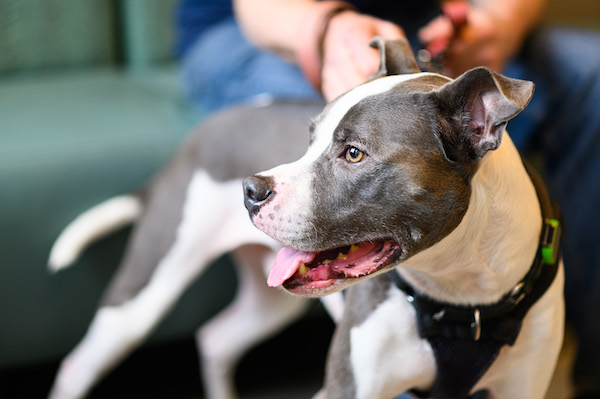Gut Microbiome Study Could Guide New Canine Epilepsy Treatments

Zeb Carter adopted his pitbull mix, Saint, from a shelter when he was 6 months old. Seven months later, Saint had his first seizure.
He was soon diagnosed with epilepsy.
“Saint’s condition was very hard on us for the first few years. He was having dozens of seizures per month,” says Carter. “It was very draining emotionally, mentally and physically for me, and it was awful for Saint physically.”
That began to change after a visit to the NC State Veterinary Hospital. In 2016, Saint participated in a clinical trial using an activity monitor to track seizures. Neurology professor Karen Muñana made medication recommendations for Saint.
Under Muñana’s guidance, he went from having the dozen bad seizures to about two mild seizures a month. Saint is now 9 years old.
“Saint is doing so well now. He still has seizures and he always will, but his quality of life has increased drastically,” says Carter. “I will always be grateful to Dr. Muñana and the wonderful staff at the hospital.”
Muñana’s work never ends with successful treatments. For more than two decades, she has been dedicated to researching the cause of canine epilepsy, the most common neurological condition in dogs but one of the least understood. Some dog breeds, including golden and Labrador retrievers seem to be genetically predisposed to the condition, but the specific underlying cause is not determined in most cases.
Now a new clinical study could help fill in some of the blanks. Funded by the American Kennel Club Canine Health Foundation, the three-year study led by Muñana is investigating the canine gut microbiome — the good and bad bacteria that naturally live in the gastrointestinal tract — for potential ties to epilepsy. It’s believed to be the first study in veterinary medicine to explore a connection between the gut microbiome and epilepsy.
“One thing that has become more prevalent over recent years is really how important the gut microbiome is,” says Muñana. “It can have effects on your immune system, on heart disease, on diabetes. And it can have an effect on the development and progression of neurologic disease.”

Muñana and her team has just finished the first year of the study, an interdisciplinary collaboration with CVM researchers including Benjamin Callahan, assistant professor of microbiomes and complex microbial communities; gastroenterology specialist Jody Gookin, professor of internal medicine and the FluoroScience Distinguished Professor in Veterinary Scholars Research Education; and Megan Jacob, associate professor and director of diagnostic laboratories.
The study is still looking for participants nationwide who can collect fecal samples at home, freeze them and mail them to the CVM. To qualify, households must have one dog with epilepsy that’s either being treated or not with medication, and also have a non-epileptic dog.
The samples will be analyzed to see whether dogs with epilepsy also have atypical changes in their microbiome. Since the study requires that dogs must live in the same environment and be fed the same food, researchers can better compare the gut microbiome samples.
Researchers will also explore whether epileptic dogs have more inflammation in the gut and if treatment with antiseizure medication makes any difference within the gut microbiome. The information could refine understanding of the mechanisms behind canine epilepsy and guide more effective treatments. About one-third of dogs with epilepsy do not respond to conventional treatments.
“The ultimate goal is widening the options for treatments but also seeing if there’s specific areas for targeted treatments,” says Muñana.
Muñana, who leads the CVM’s Companion Animal Epilepsy research lab, is a world leader in canine epilepsy treatment and research.
When the International Veterinary Epilepsy Task force was formed in 2014, Muñana was one of just a few in the United States who were invited to join. A diplomate of the American College of Veterinary Internal Medicine in Neurology, Muñana was also one of just four in the U.S. asked to join an ACVIM consensus panel on how to manage epilepsy in dogs.
Just a handful of veterinary schools in the United States are known for canine epilepsy research and even fewer are noted for specializing in canine epilepsy treatment. Muñana and NC State are widely recognized as leaders in both. The veterinary hospital typically sees more than 500 dogs a year with seizures.
“At the time I participated in my first epilepsy study more than 20 years ago, canine epilepsy had been recognized for a long time, but it just wasn’t an active area of research,” says Muñana. “I think the general thought was there is evidence that it is a genetic disease, but the specifics are not well understood so all we can do is treat symptomatically with medication.
“The hope still is that we can really achieve a greater understanding of what is involved in epilepsy’s cause in addition to genetics.”
As with the human form, canine epilepsy is characterized by a range of seizure types and is commonly treated with medication. The most common treatment for dogs is phenobarbital, but because dogs metabolize medications differently that humans, they do not have as many treatment options for epilepsy as people do.
The majority of seizures are mild — most stop on their own — and impact dogs that are otherwise healthy, often young; dogs can first experience seizures between 6 months and 6 years old, says Muñana. Dogs can experience a seizure, have no seizures for three weeks, and then have another mild seizure.
The ultimate goal is widening the options for treatments but also seeing if there’s specific areas for targeted treatments. — CVM neurology professor Karen Muñana.
But there are also instances, Muñana says, when the mechanism that typically stops seizures doesn’t. That can be life-threatening.
“A lot of the dogs are normal most of the time, and the problem is you can’t predict when a seizure will happen,” says Muñana. “It puts owners on edge. It’s not like managing a chronic condition like diabetes where you know what to do each day. People ask themselves, ‘Am I going to leave my dog today when they’re going to have a seizure?”
One of the most rewarding aspects of Muñana’s career has been working so closely with owners of epileptic dogs. Like Carter, many feel helpless when their pets first experience seizures and that feeling lingers without concrete information. Muñana talks with owners in detail about what to expect and addresses fears owners may have that they are doing something wrong.
Muñana and the neurology service also helps owners connect with others with epileptic dogs, often through online support groups. Owners of epileptic dogs are particularly passionate about sharing information with one another and volunteering for clinical studies.
Those who had felt helpless now send messages of hope. Carter once sent Muñana a photo of Saint wearing a party hat with a sign proclaiming, “100 days seizure-free.”

“Owners of epileptic dogs are on the biggest groups that are leveraging research in veterinary medicine, and this makes a tremendous difference,” says Julie Nettifee, a research specialist in neurology who works closely with Muñana and canine epilepsy patients at the CVM. “Owners are so vested and so driven and so passionate. These are their family members.”
In Muñana’s office, she keeps a book that an owner of a dog with epilepsy put together, packed with stories of dogs with epilepsy. Muñana has not seen all of these dogs clinically, but as she flips the pages, she pauses at each photo and story, quietly taking each in.
“It’s the little things, the little bits of hope that make a difference,” says Muñana. “If we just find one thing we can do different or one thing we can even consider to help dogs that suffer from uncontrolled seizures, it is all important. There are still a lot of questions about it, but each small step helps.”
~Jordan Bartel/NC State Veterinary Medicine
Photography for this story was taken prior to enhanced COVID-19 safety and mask protocol established for CVM faculty, staff and students, as well as the general public. The latest information on our protocol can be found here: https://news.cvm.ncsu.edu/coronavirus-update-nc-state-veterinary-hospital/


